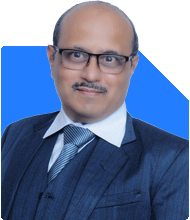Can a 6 Lakh SIP get me 20 Crore in 10 Years?
Ramalingam Kalirajan |10893 Answers |Ask -Follow
Mutual Funds, Financial Planning Expert - Answered on Nov 02, 2024
He has an MBA in finance from the University of Madras and is a certified financial planner.
He is the director and chief financial planner at Holistic Investment, a Chennai-based firm that offers financial planning and wealth management advice.... more

I want to invest 6 lakh per month in SIP. I have selected these funds and weightage. JM Flexicap - 30%, Motilal Oswal Midcap - 40%, Tata Small Cap - 15% and Quant Small Cap - 15%. Investing for 10 years. Goal is 20 crores in 10 years or bit longer is also fine.
Investing Rs 6 lakhs per month is a commendable goal. Your chosen allocation reflects a growth-oriented approach, focusing on flexicap, midcap, and small-cap funds. This strategy can offer strong growth potential, but balancing returns with risk is essential. Let’s assess each aspect to help you reach your target of Rs 20 crores over 10 years or slightly longer.
1. Evaluation of Chosen Fund Allocation
The fund allocation you've chosen comprises flexicap, midcap, and small-cap funds. Here’s how this breakdown aligns with a 10-year goal.
Flexicap (30%): Flexicap funds offer a balanced exposure across large, mid, and small caps. This flexibility allows fund managers to shift between sectors based on market conditions, offering both stability and growth.
Midcap (40%): Midcap funds bring higher growth potential compared to large caps. However, they also come with higher volatility. A 40% allocation to midcap is aggressive but can perform well over the long term.
Small-Cap Funds (30%): Small-cap funds have high growth potential, especially over a 10-year horizon. However, they are also the most volatile, especially in short-term market downturns.
Assessment: Your allocation is weighted towards mid- and small-cap funds, which are growth-oriented. It’s important to remember that while these categories can offer high returns, they can also be volatile, especially during economic downturns. Flexicap funds bring some balance, but if you seek reduced risk, consider adjusting these weights slightly.
2. Risk vs. Return Potential
For a Rs 20 crore target, you need an average annual growth rate that is achievable with your allocation. However, balancing the risk of such high-growth funds is crucial.
High Risk, High Return: Mid- and small-cap funds are known for delivering high returns, but they also have periods of underperformance. The flexicap component will moderate some of this risk but may not completely stabilize the portfolio.
Market Volatility Consideration: Mid- and small-cap funds are more sensitive to market changes, making them subject to higher volatility. Over 10 years, the probability of achieving your goal is high, but there will be years with dips, so be prepared for market fluctuations.
Insight: Your goal is feasible with the selected allocation. However, if you prefer to limit volatility, consider reducing the small-cap allocation and adding a slightly higher proportion in flexicap or even large-cap funds.
3. Tax Implications and Strategy
When building a large corpus, tax efficiency is critical, as it impacts your net returns significantly.
Equity Mutual Funds: Your investments are subject to long-term capital gains (LTCG) tax if held for over one year. Under current rules, LTCG on equity funds above Rs 1.25 lakh is taxed at 12.5%. Short-term capital gains (STCG) are taxed at 20% if you sell before one year.
Tax Optimization Strategy: Since your investments will be over a decade, the LTCG tax will apply. Ensuring that withdrawals are planned can help minimize the tax impact, especially if you spread the withdrawal period to fall within lower tax years.
Assessment: Your SIPs should be held with a long-term focus. Plan withdrawals carefully to optimize tax liability and reduce any immediate tax burden.
4. Reviewing Direct vs Regular Plan Investment
If you’re considering direct funds, note the potential drawbacks, particularly for high-stakes goals like Rs 20 crores.
Direct Funds: Although direct funds offer a lower expense ratio, they require active management and monitoring. They lack the guidance that can be crucial for long-term investors, especially if market conditions change.
Regular Plans Through CFP: Investing in regular plans through a Certified Financial Planner (CFP) offers professional guidance. A CFP can help you adjust your allocation, monitor fund performance, and make timely rebalancing decisions.
Recommendation: For high-value goals, regular plans with CFP guidance provide greater support. This approach ensures your investment plan remains aligned with your objectives and risk tolerance.
5. Potential for Rebalancing and Adjustments
Over a decade, regular rebalancing can improve returns and reduce risk. Here’s why rebalancing matters:
Managing Risk Levels: Rebalancing adjusts your portfolio based on market conditions and can help manage risk levels as you get closer to the goal. For example, shifting from small-cap to more stable funds can lock in gains.
Aligning with Financial Goals: Periodic adjustments keep your portfolio aligned with changing financial goals or market conditions. This also allows you to take advantage of high-performing sectors.
Action Plan: Set up a rebalancing schedule, preferably annual, to maintain your desired risk level and optimise returns. A CFP can assist with this.
6. Planning for Liquidity Needs
In high-growth portfolios, it’s wise to plan liquidity carefully.
Liquidity for Emergencies: While your portfolio is growth-oriented, consider setting aside a small portion in liquid or ultra-short-term debt funds. This ensures quick access to funds without impacting your equity portfolio.
Exit Strategy: For achieving Rs 20 crores, consider an exit strategy closer to your target year. You can gradually move funds into more stable, low-volatility investments like large-cap funds or conservative debt funds to preserve accumulated wealth.
Action Plan: Consider a systematic transfer strategy to safer funds in the last 2-3 years before your target. This reduces exposure to market risks as you approach your goal.
7. Monitoring Performance Over Time
Ongoing monitoring is essential for achieving long-term financial goals.
Evaluating Fund Performance: Assess fund performance at least annually. Ensure that each fund meets your expected return and risk parameters. If a fund underperforms consistently, consider replacing it with a better-performing option.
Using a Benchmark: Compare each fund’s performance against a relevant benchmark, such as Nifty Midcap for mid-cap funds. This provides insight into whether the fund is adding value or merely following the index.
Action Plan: Use regular reviews to stay informed about your funds’ performance. Consult a CFP for guidance on underperforming funds or market changes.
8. Final Insights
Your investment plan aligns well with your goal of Rs 20 crores. With a growth-oriented approach, the selected funds provide an excellent opportunity to achieve your financial target over 10 years. Balancing returns and risk, however, is essential. Here’s a recap:
Flexicap, mid-cap, and small-cap funds are well-suited for long-term growth but carry market risk.
Rebalancing and liquidity planning can further protect your portfolio, especially as you near your target.
Monitor performance annually and make adjustments if needed. Working with a Certified Financial Planner (CFP) will help ensure that your investments remain aligned with your financial goals.
Best Regards,
K. Ramalingam, MBA, CFP,
Chief Financial Planner,
www.holisticinvestment.in
https://www.youtube.com/@HolisticInvestment
Best Regards,
K. Ramalingam, MBA, CFP,
Chief Financial Planner,
www.holisticinvestment.in
https://www.youtube.com/@HolisticInvestment
You may like to see similar questions and answers below
Sanjeev Govila | Answer |Ask -Follow
Financial Planner - Answered on Feb 06, 2024
Ramalingam Kalirajan |10893 Answers |Ask -Follow
Mutual Funds, Financial Planning Expert - Answered on May 30, 2024
Ramalingam Kalirajan |10893 Answers |Ask -Follow
Mutual Funds, Financial Planning Expert - Answered on Apr 05, 2024
Ramalingam Kalirajan |10893 Answers |Ask -Follow
Mutual Funds, Financial Planning Expert - Answered on May 07, 2024
Nitin Narkhede |113 Answers |Ask -Follow
MF, PF Expert - Answered on Dec 15, 2025
Nitin Narkhede |113 Answers |Ask -Follow
MF, PF Expert - Answered on Dec 15, 2025
Ramalingam Kalirajan |10893 Answers |Ask -Follow
Mutual Funds, Financial Planning Expert - Answered on Dec 15, 2025
Ramalingam Kalirajan |10893 Answers |Ask -Follow
Mutual Funds, Financial Planning Expert - Answered on Dec 15, 2025
Radheshyam Zanwar |6746 Answers |Ask -Follow
MHT-CET, IIT-JEE, NEET-UG Expert - Answered on Dec 15, 2025
Ramalingam Kalirajan |10893 Answers |Ask -Follow
Mutual Funds, Financial Planning Expert - Answered on Dec 15, 2025
Ramalingam Kalirajan |10893 Answers |Ask -Follow
Mutual Funds, Financial Planning Expert - Answered on Dec 15, 2025
Ramalingam Kalirajan |10893 Answers |Ask -Follow
Mutual Funds, Financial Planning Expert - Answered on Dec 15, 2025
Samraat Jadhav |2508 Answers |Ask -Follow
Stock Market Expert - Answered on Dec 15, 2025
Ramalingam Kalirajan |10893 Answers |Ask -Follow
Mutual Funds, Financial Planning Expert - Answered on Dec 15, 2025

























